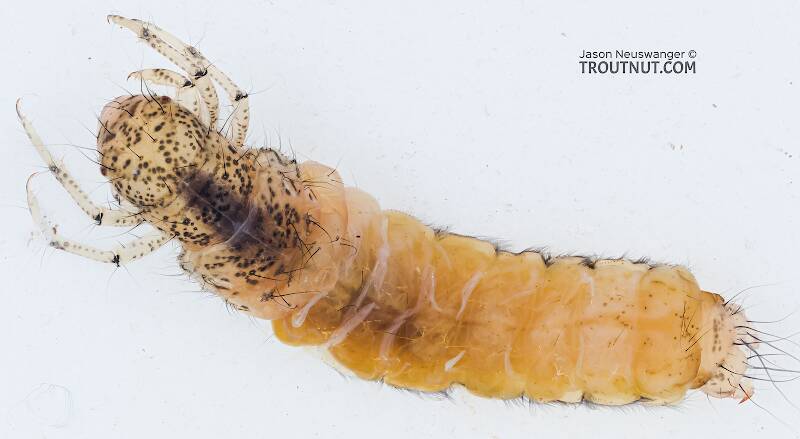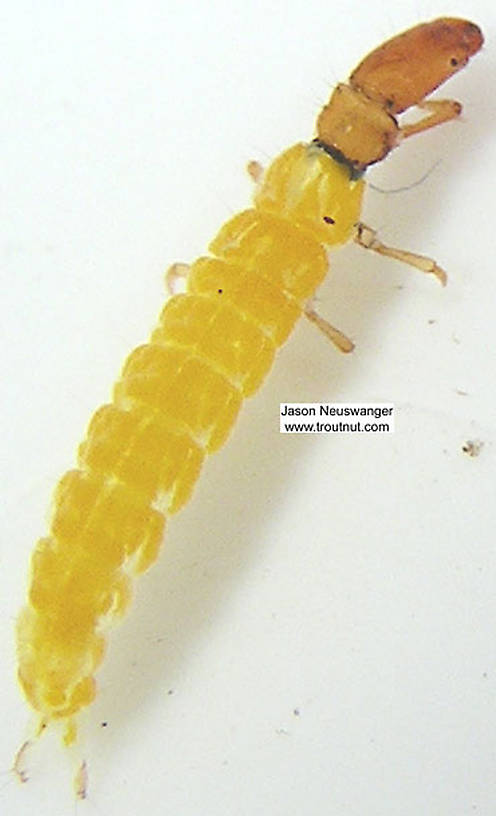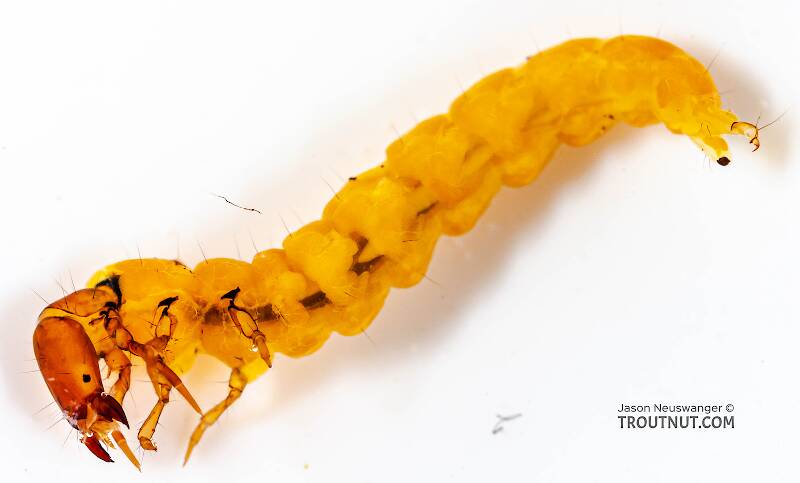
Blue-winged Olives
Baetis
Tiny Baetis mayflies are perhaps the most commonly encountered and imitated by anglers on all American trout streams due to their great abundance, widespread distribution, and trout-friendly emergence habits.
Featured on the forum

This is a striking caddis larva with an interesting color pattern on the head. Here are some characteristics I was able to see under the microscope, but could not easily expose for a picture:
- The prosternal horn is present.
- The mandible is clearly toothed, not formed into a uniform scraper blade.
- The seems to be only 2 major setae on the ventral edge of the hind femur.
- Chloride epithelia seem to be absent from the dorsal side of any abdominal segments.
Based on these characteristics and the ones more easily visible from the pictures, this seems to be Grammotaulius. The key's description of the case is spot-on: "Case cylindrical, made of longitudinally arranged sedge or similar leaves," as is the description of the markings on the head, "Dorsum of head light brownish yellow with numerous discrete, small, dark spots." The spot pattern on the head is a very good match to figure 19.312 of Merritt R.W., Cummins, K.W., and Berg, M.B. (2019). The species ID is based on Grammotaulius betteni being the only species of this genus known in Washington state.
- The prosternal horn is present.
- The mandible is clearly toothed, not formed into a uniform scraper blade.
- The seems to be only 2 major setae on the ventral edge of the hind femur.
- Chloride epithelia seem to be absent from the dorsal side of any abdominal segments.
Based on these characteristics and the ones more easily visible from the pictures, this seems to be Grammotaulius. The key's description of the case is spot-on: "Case cylindrical, made of longitudinally arranged sedge or similar leaves," as is the description of the markings on the head, "Dorsum of head light brownish yellow with numerous discrete, small, dark spots." The spot pattern on the head is a very good match to figure 19.312 of Merritt R.W., Cummins, K.W., and Berg, M.B. (2019). The species ID is based on Grammotaulius betteni being the only species of this genus known in Washington state.

Troutnut is a project started in 2003 by salmonid ecologist Jason "Troutnut" Neuswanger to help anglers and
fly tyers unabashedly embrace the entomological side of the sport. Learn more about Troutnut or
support the project for an enhanced experience here.
This topic is about the Caddisfly Genus Chimarra
Chimarra aterrima is the most important species.Example specimens
Frankcoz
Posts: 1
Posts: 1
Frankcoz on Mar 27, 2008March 27th, 2008, 12:31 am EDT
Seems like dead drifting the pupa pattern during the emergence time is a good way to fish this before the adults are on the water.
Does the pupa retain the orange color of the larva or do they have the color of the adult?
Does the pupa retain the orange color of the larva or do they have the color of the adult?
JAD on Mar 27, 2008March 27th, 2008, 2:33 am EDT
I think you have the right idea, I tie it with Golden stone fly dub with a peacock head size 18 and 20 .
John
They fasten red (crimson red) wool around a hook, and fix onto the wool two feathers which grow under a cock’s wattles, and which in colour are like wax.
Radcliffe's Fishing from the Earliest Times,
Martinlf on Mar 27, 2008March 27th, 2008, 11:55 am EDT
I think the pupa itself is dark. For the larvae orange or golden is great, for the pupa I like a little peacock and starling wet fly.
"He spread them a yard and a half. 'And every one that got away is this big.'"
--Fred Chappell
--Fred Chappell
Zap on Mar 28, 2008March 28th, 2008, 1:53 pm EDT
I've had some luck with a small 18 quill larva. It appears somewhat tannish --with a brown head and ginger hackle. I'm not sure if it's the pupa for the chimmara but it 's gotten some fish during the time thses flies are to be expected. I used stems from hen hackles for the body. TZ
GONZO on Apr 5, 2008April 5th, 2008, 2:53 pm EDT
Frankcoz, as a good general rule, the body color of a caddisfly pupa will be about the same as that of a freshly hatched adult. This is because what fly fishers call a "pupa" is technically a pharate adult. However, it is also good to keep in mind that caddisfly adults often darken considerably over time, so "aged" specimens shouldn't be used as models for pupal patterns.
Peregrines
Posts: 2
Posts: 2
Peregrines on Apr 5, 2012April 5th, 2012, 8:59 am EDT
A couple years too late for the original poster by for others that might be curious....
As Gonzo points out emerging pupae have the color of the adult. For imitating the Chimera hatch LaFontaine recommends:
Larva: Yellow caddis larva
Pupa: Black Deep or Black Emergent Sparkle Pupa
Adult: Black Dancing Caddis or Thompson's Foam Caddis
Egg layer: Black Diving Caddis
mark
As Gonzo points out emerging pupae have the color of the adult. For imitating the Chimera hatch LaFontaine recommends:
Larva: Yellow caddis larva
Pupa: Black Deep or Black Emergent Sparkle Pupa
Adult: Black Dancing Caddis or Thompson's Foam Caddis
Egg layer: Black Diving Caddis
mark
Entoman on Apr 5, 2012April 5th, 2012, 11:08 am EDT
Mark,
You left out a very important part of that quote. Freshly hatched adults are very different in color from the adults that have been around awhile. It's the latter trout usually see most often.
As Gonzo points out emerging pupae have the color of the adult
You left out a very important part of that quote. Freshly hatched adults are very different in color from the adults that have been around awhile. It's the latter trout usually see most often.
"It's not that I find fishing so important, it's just that I find all other endeavors of Man equally unimportant... And not nearly as much fun!" Robert Traver, Anatomy of a Fisherman
Quick Reply
Related Discussions
Topic
Replies
Last Reply






